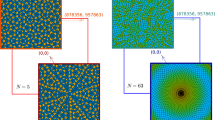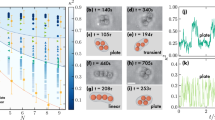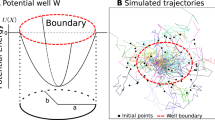Abstract
THE apparently simple problems of (1) how many short lines (‘cars’) of the same length can be randomly placed (‘parked’) in non-overlapping fashion on a line (‘street’); (2) how many squares (Fig. 1) or disks (Fig. 2) of the same size can be randomly placed in an area without overlapping; (3) how many solid spheres (atoms) can be randomly packed in a given volume, are of interest from both physical and mathematical points of view, and occur in various situations1. Our interest in the two-dimensional problem arises from a computer simulation2,3 of particles in cell membranes. When the membrane bilayer is split into two leaflets by freeze-fracture method4 and an area of the split membrane is visualised by electron microscopy, then the embedded membrane particles (believed to be predominantly proteinaceous) are seen as circular shapes. In natural membranes the unaggregated particles seem to be random in position, and the areal density of the particles may be high. It seems that nature has provided us with a two-dimensional example of (nearly) maximum random parking. Hence we have estimated the maximum fractional area covered by circular disks on a two-dimensional membrane, using a computer simulation with periodic boundary conditions. The correspondence with particles in a biological membrane has implications for membrane biogenesis.
This is a preview of subscription content, access via your institution
Access options
Subscribe to this journal
Receive 51 print issues and online access
$199.00 per year
only $3.90 per issue
Buy this article
- Purchase on Springer Link
- Instant access to full article PDF
Prices may be subject to local taxes which are calculated during checkout
Similar content being viewed by others
References
Solomon, H. Proc. 5th Berkeley Symp. Math. Statist. Probability 3, 119–134 (1967).
Finegold, L. Biochem. biophys. Acta 448, 393–398 (1976); Proc. Workshop on Physical Chemical Aspects of Cell Surface Events in Cellular Regulation (ed. Delisi, C.) (Elsevier, New York, 1979).
Donnell, J. T. thesis, Drexel Univ. (1979).
Sleytr, U. B. & Robards, A. W. J. Microsc. 111, 77–100 (1977).
Palásti, I. Magy. tudom. Akad. Mat. Kut. Intéz. Közl. 5, 353–360 (1960).
Akeda, Y. & Hori, M. Nature 254, 318–319 (1975).
Akeda, Y. & Hori, M. Biometrica 63, 361–366 (1976).
Rotham, J. E. & Lenard, J. Science 195, 743–753 (1977).
Singer, S. J. J. supramolec. Struct. 6, 313–323 (1977).
Author information
Authors and Affiliations
Rights and permissions
About this article
Cite this article
FINEGOLD, L., DONNELL, J. Maximum density of random placing of membrane particles. Nature 278, 443–445 (1979). https://doi.org/10.1038/278443a0
Received:
Accepted:
Issue Date:
DOI: https://doi.org/10.1038/278443a0
This article is cited by
-
Computer simulation of random sequential adsorption of two interacting species on a lattice
Journal of Statistical Physics (1994)
-
Random sequential addition: A distribution function approach
Journal of Statistical Physics (1991)
-
Geometry of random sequential adsorption
Journal of Statistical Physics (1986)
Comments
By submitting a comment you agree to abide by our Terms and Community Guidelines. If you find something abusive or that does not comply with our terms or guidelines please flag it as inappropriate.



